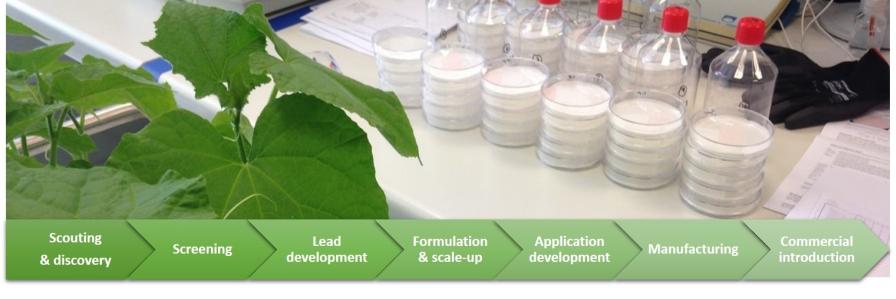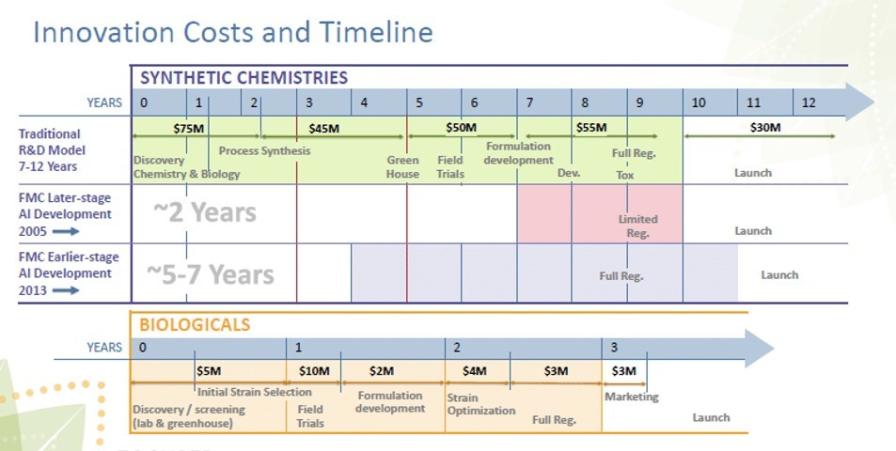Biorational Processes in Biopesticide Discovery and Development
Agchem companies are expanding their biopesticide R&D and portfolios, driven by stricter pesticide regulatory requirements, consumer awareness regarding hazards caused by chemical pesticides, and the phasing out of conventional toxic pesticides.
One of the critical challenges to this process is the discovery and development of biopesticidal candidates.
Biopesticide discovery and development follows a biorational process of scouting/discovery and screening over lead development, formulation, and scale-up, to application development, manufacturing, and commercial introduction.
Biorational process: the design and implementation of biopesticide discovery and development processes through screening (and the conservation of) specific biological effects (including pest and pathogen control, crop stress alleviation, and enhanced plant resilience) against the pathogens and pests they are intended to control.

Figure 1: Biopesticide Discovery & Development Processes.
Biopesticide Scouting
Biopesticide scouting: the identification of biopesticidally-active natural candidate species — includes observation in the field (the identification of plants showing exceptional natural growth or pest-defense responses) as well as ethnobotanical, anatomical, and physiological indicators to identify potential candidates.
Ethnobotany: the scientific study of traditional knowledge and customs regarding plants and their uses.
Bioinsecticide Discovery
Predating the development of synthetic pesticides during and after WWII, the ethnobotany of plant-derived pesticides — primarily insecticides — dates back at least two thousand years to Asia and the Mediterranean regions. In Europe and North America, plant-derived pesticides date back more than 150 years.
One of the most-cited ethnobotanical bioinsecticide examples is the use of plants of the genus Pyrethrum (now classified as Chrysanthemum or Tanacetum) in insecticide preparations, dating back to Persia about 400 B.C. Brought to Europe in the early 19th century, dried and ground flowers of Dalmatian chrysanthemum (Tanacetum cinerariaefolium) were used to control body lice during the Napoleonic Wars. Today, pyrethrum and its pyrethroid synthetic analogues are among the most widely-used biological and conventional insecticides.
Neem (Azadirachta indica) is an evergreen tree native to the Indian sub-continent, used for thousands of years against household and storage pests, as well as pests related to field crops, and currently attracting global attention due to its potential as a commercial biopesticide.
Biofungicide Discovery
In 1988, East German scientists tasked with the production of spores of the fungal plant pathogen, Sclerotinia trifoliorum, discovered that a fungal parasite inhibited the pathogen. Recognizing its potential as a natural pesticide process, C. minitans was successfully developed as a commercial biopesticide by its discoverers, following the reunification of Germany.
The discovery that non-pathogenic microbes can induce plant defense responses is undoubtedly not new. My grandfather — famous for his roses which never seemed to be afflicted by mildew — would follow his grandfather’s example, and spray yeast-rich beer dregs over his roses.
We now understand that the exposure of fungal yeast cells to plant leaves leads to the induction of plant defense responses, as the plants believe themselves to be under invasion by a potential fungal pathogen.
The EU pesticides database for Basic Substances (substances with a low toxicity profile not predominantly used for plant protection purposes but which could be useful in plant protection) includes Beer as one of the only 18 approved substances, while one of only 10 approved Low-risk Active Substances is Brewer’s Yeast (Saccharomyces cerevisiae) — approved for use as a fungicide.
In a more recent example, Burkina Faso farmers are — together with researchers at Copenhagen University — testing the effects of a local plant (False Daisy, Eclipta alba) discovered to contain antifungal compounds, to develop inexpensive plant extracts capable of replacing synthetic fungicides.
Biofungicide discovery is currently being driven using biotech tools, including the monitoring of defense-related gene expression, pathogenesis-related proteins, bioinformatics (the collection, classification, storage, and analysis of biochemical and biological information using computers), and genomic analysis.
Bioherbicide Discovery
Bioherbicide discovery typically involves the study of biochemical processes specific to plants, including photosynthesis, amino acid biosynthesis, chlorophyll and carotenoid biosynthesis, and growth regulation (phytohormones).
Our growing understanding of these plant-specific processes is facilitating the identification of new herbicides’ sites of action, permitting the screening and development of bioherbicidally active metabolites with low mammalian toxicity, shorter environmental persistence, and novel target specificity.
Biopesticide Lead Development
In biopesticide lead development, microbes isolated from soil and plant microbiomes associated with plants showing exceptional growth or natural pest-defense responses are sequenced and compared against a database of known pathogens. Matches are discarded, while the remainder transition to bioassay screening to identify biostimulatory or biopesticidal effects.
Potential leads are analyzed and characterized to ensure the absence of toxins, before embarking on a process of lab and field testing, fermentation process development, formulation, and scale-up.
Each of the steps in this process of biorational development are subject to considerable challenges, but for biological pesticide development the transition from lab to field testing is one of the most crucial. The correlation between a greenhouse result and a field result is not necessarily a given.
This is in part due to the complexity of biotic and abiotic factors affecting microbial characteristics, and the transient formulation stability of naturally-derived metabolites and microbes. The latter factor — rapid degradation by ultraviolet light, oxygen, and microbial activity — contributes to shorter environmental persistence, a key factor driving the acceptance of biopesticides.
For conventional chemistries, development times can be three times longer than for biological crop protection development, while expenses may be as much as 10 times greater.

Figure 2: Innovation costs and timelines for conventional and biological crop protection development (from: FMC – Investor Relations Solutions, 2015).
Industry figures suggest that the R&D process for a novel synthetic pesticide costs more than 250 million USD and requires 10 years of development, while the development of a biopesticide may cost 25 million USD and require three years of development.
Because of these differences, agbio start-ups and other local, innovative companies have created a robust and competitive environment for biopesticide discovery and development, and the current wave of acquisitions, collaboration, and licensing agreements with the incumbent agchem industry bear witness to an ongoing symbiosis in the field of biopesticide R&D.
Thanks for reading. Please feel free to read and share my other articles.
For more information, visit BioScience Solutions, which contributes to the development of sustainable crop protection solutions by providing independent strategic R&D management and scientific support to agchem and biosolutions businesses developing science-based products.






